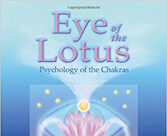Eye of the Lotus: Psychology of the Chakras is a book of observations about the seven chakras of the human biofield and how they really work. It is meant to be a deep exploration into how our chakras affect the way we perceive reality, affecting our responses.

The chakras are not limited to time or space, yet they exist. Many spiritual consultations and research into the chakras as centers of consciousness (not just energy) led me to a theory that one of the seven chakras would be more “dominant” than the others. The chakras, as centers of consciousness, affect the flow of consciousness between dimensions of individuation (the three yoga bodies: physical, astral and causal), and they affect the four archetypes of the “whole human being:” physical, mental, spiritual and emotional.
I have found in my 30+ years that most people are not aware of the depth of how the chakras work and that their impressions were mostly how they chakras affect the physical nature, including applications like acupuncture and other Eastern traditional medicine approaches.
In this theory I found that each chakra has one or more psychic abilities that are “on” 24/7 (but not cultivated in many people). Imagine: all your chakras functioning 24/7, all with intuitive abilities working. In fact, we take a psychic relationship to each other long before the mind thinks a single thought. It is fascinating, because all of these abilities are innate, just waiting to be awakened, but most are unaware of the inner power of the chakras as conduits of consciousness to higher dimensions of awareness.
As for dominant chakra think: right-handed. You may be right-handed and that is the one you favor, but your left hand works just fine. All chakras are centers of consciousness and intuition., but let’s say if the heart chakra were dominant and the main psychic ability is empathy, then that person would tend to be more empathic, coloring their perceptions (and reactions) than the other chakras, even though they are all active.
This affect is a lifelong influence on a person’s life and character, and often stems from development in past lives to this one.
The research into dominant chakra theory led me to write Eye of the Lotus: Psychology of the Chakras: as at the time there were no other writings that approached the function and affect of the chakras in this manner towards the whole human being. The reasoning is to allow the reader a deeper insight into why one responds they way they do to life’s situations and circumstances.
Each chapter on a chakra is an in-depth look at how the psychic abilities affect the perception of reality, even to the point of how each chakra creates in the egoic mind fears that are specific to that chakra. This is most fascinating, because it takes the reader away from the point of view that a chakra is a mechanism to a whole new viewpoint that chakras as conduits of higher levels of awareness are actually teachers that set up those situations and circumstances that offer the opportunity for one to grow spiritually to higher states of awareness.
Each chapter on the chakras also discusses what are called higher and lower aspects; the higher aspects from awakening the chakras and being in balance, the lower aspects from illusion and feeling separate from the oneness.
The appendix is huge: many exercises and methods to stimulate and balance the chakra system. This book has been used as reference and study material at several universities.
This short blog only scratches the surface. Eye of the Lotus is definitely not a “read it once” book.

Dr. Richard Jelusich is a gifted intuitive spiritual counselor/energy healer, author, teacher, experienced international speaker, and ordained minister. With over 34 years in the field of spirituality and the study of metaphysics, he now dedicates his life to those on a quest for self-empowerment through education, demystifying metaphysics and assisting individuals to honor their natural gifts and inner truths.



